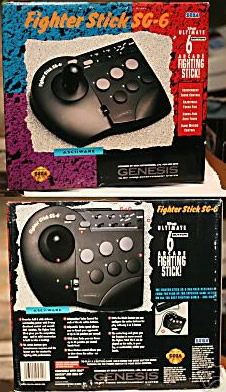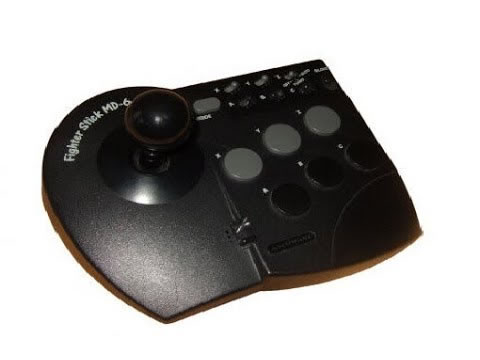 “I know what you’re thinking. Is it six buttons, or only three? Well, to tell you the truth, in all this excitement I kinda lost track myself. But being this is an ASCII Arcade Stick, the coolest arcade pad in the world, and will blow your friends clean away, you’ve got to ask yourself one question… ‘Am I a fighter?’ Well, are you, punk?” Okay, so that would be a pretty hokey print ad. That’s why I’m just a reviewer instead of a marketing director. But to answer the question, it is a six-button pad. On the other hand, it’s not made by Sega.
“I know what you’re thinking. Is it six buttons, or only three? Well, to tell you the truth, in all this excitement I kinda lost track myself. But being this is an ASCII Arcade Stick, the coolest arcade pad in the world, and will blow your friends clean away, you’ve got to ask yourself one question… ‘Am I a fighter?’ Well, are you, punk?” Okay, so that would be a pretty hokey print ad. That’s why I’m just a reviewer instead of a marketing director. But to answer the question, it is a six-button pad. On the other hand, it’s not made by Sega.
Now, I know that many of you have had bad experiences with third-party controllers and are probably pretty wary right about now. (Turbo Touch 360, anyone?) After all, why go with something like this when you could get an official version from Sega? Well, one reason would be how hard it is to actually find a functional six-button Sega Arcade Stick for a decent price. Like most third-party controllers, however, the Fighter Stick is about as common as the flu in January and can be had MIB for about the price of a pack of gum. Definitely a point in its favor, but if the design is shoddy then you’d be better off with the Juicy Fruit, right? Let’s check it out.
The first thing I noticed when I picked up the stick was how heavy it was. This is due, upon closer inspection, to a metal plated bottom. A nice thought, and much more welcome than the standard suction cups we see so often on these things. And no worries about your furniture – it won’t scratch up your tabletop, thanks to four felt pads on the corners. But, as Ken said in the Accessories and Peripherals Guide, this same metal is prone to rusting. I’ve seen a bunch of these in the wild, and many were indeed corroded and gunked up by improper care. If you can get one new, however, it shouldn’t be a problem to keep clean. We’re classic gamers, for cryin’ out loud, and if we can keep a rare Japanese box insert in mint condition we can keep from spilling our sodas all over our controllers. Right?
One thing I really loved about the stick was the turbo scheme. For one thing, there’s an individual turbo switch for each individual button as well as an ‘auto’ option. Slow motion is present as well, but the best feature has to be the nifty ‘turbo rate’ slider. You know how often times the turbo setting is so fast that the game’s coding can’t handle all the input? In Shadow Squadron, for instance, using a turbo switch for the fire button is actually slower than hammering the button yourself. The Fighter Stick allows you control just how…well, ‘turbo-ey’ the switch is. And by fiddling with this slider you can find the perfect balance of speed and functionality. This was a brilliant idea that I really loved. I know that turbo is cheating, but if you’re going to cheat you should do it in style. This stick helps you do that.
The buttons themselves are mostly responsive and even oversized, so no more fumbling for the right key in the middle of an intense match. Unfortunately they’re not the quiet, cushioned variety you might be used to with your other game pads. They’re the kind made out of hard plastic that clack every time you press them. I don’t know about you, but all that clattering drives me absolutely crazy. The joystick itself is actually pretty decent, although it’s certainly not set to a hair-trigger; I found myself having to heave the thing around in order to get the movements to register. Since I own a factory-sealed unit in addition to a used one, I’m led to believe that this is a design problem common to all Fighter Sticks. On the plus side, the ball of the stick is sized perfectly, suitable for any grip style, whether it be the palm of your hand or your fingers.
 But the number one problem with the Fighter Stick is undoubtedly the fact that the entire assembly is too small and crowded. I’m not referring only to the tiny hand rest on the left side, but also to the proximity of the pad and joystick. It’s the exact opposite of ergodynamic, and I even found my hand cramping up after a session of Street Fighter II. Worse (in some ways) was the drastic drop in gaming quality. I’m no newbie, but I had to use a continue against Chun-Li. The horror! I attribute this heinous embarrassment mostly to the spartan distribution of free space – my hand kept slipping off the at the most inopportune times and I was unable to find a comfortable position until several hours of play. Others might find it easier to adjust, but this was all very unsettling to one used to comparatively spacious arcade cabinets. Maybe ASCII was trying to save money by making it smaller, I don’t know. It was a bad idea, regardless.
But the number one problem with the Fighter Stick is undoubtedly the fact that the entire assembly is too small and crowded. I’m not referring only to the tiny hand rest on the left side, but also to the proximity of the pad and joystick. It’s the exact opposite of ergodynamic, and I even found my hand cramping up after a session of Street Fighter II. Worse (in some ways) was the drastic drop in gaming quality. I’m no newbie, but I had to use a continue against Chun-Li. The horror! I attribute this heinous embarrassment mostly to the spartan distribution of free space – my hand kept slipping off the at the most inopportune times and I was unable to find a comfortable position until several hours of play. Others might find it easier to adjust, but this was all very unsettling to one used to comparatively spacious arcade cabinets. Maybe ASCII was trying to save money by making it smaller, I don’t know. It was a bad idea, regardless.
Overall I found the Fighter Stick to be a worthy controller. It provided a more authentic playing experience for my shmups, even though it was a bit too tight for comfort during long gaming sessions, especially with versus fighters. For those who won’t use it often or for extended periods, or for those who are looking for a cheap alternative to Sega’s own six-button arcade pad, look no further than the SG. It has its faults, but for casual play it should suffice nicely.


Recent Comments